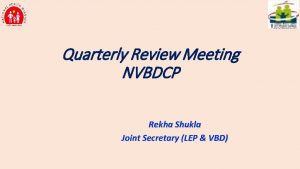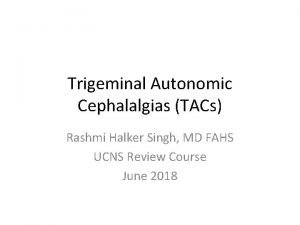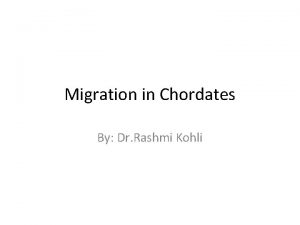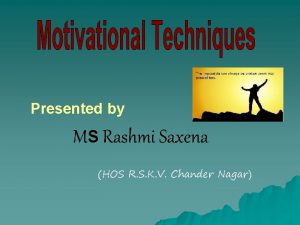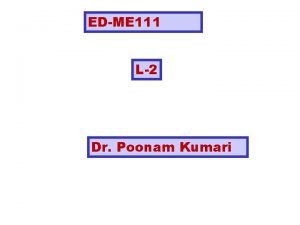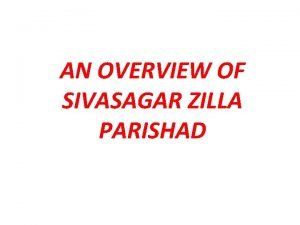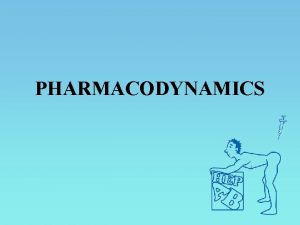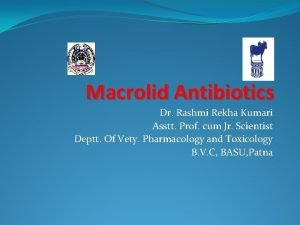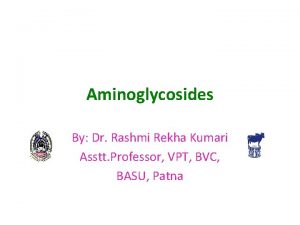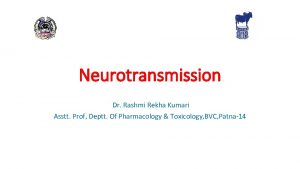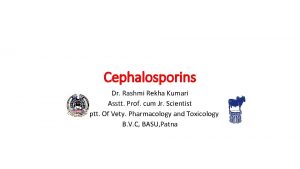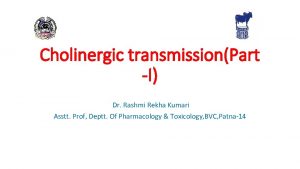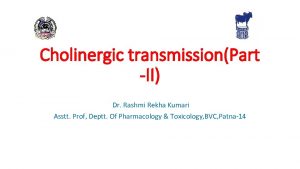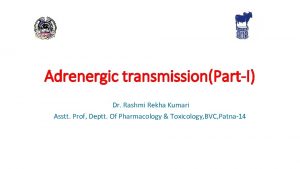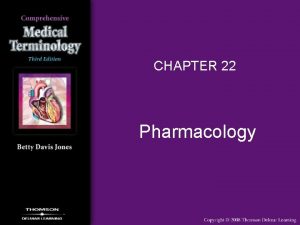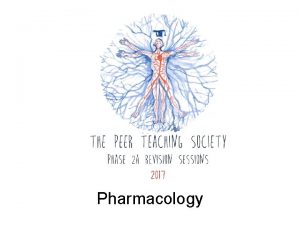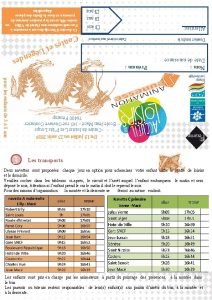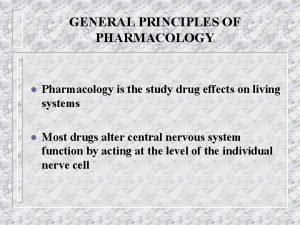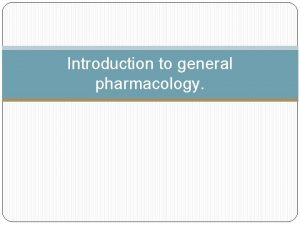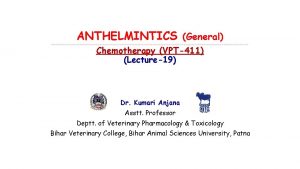ANS Pharmacology General ConsiderationsPartI Dr Rashmi Rekha Kumari























- Slides: 23

ANS Pharmacology: General Considerations(Part-I) Dr. Rashmi Rekha Kumari Asstt. Prof, Deptt. Of Pharmacology & Toxicology, BVC, Patna-14

Pharmacology Study of drug ANS Pharmacology Study of drug acting on Autonomic Nervous System

Drugs Acting on ANS Parasympathomimetic drugs(cholinergic) and Parasympatholytic(Anticholinergic) drugs Sympathomimetic(Adrenergic)/sympatholytic(Antiadrenergic) drugs

Autonomic Nervous System: General considerations Nervous System Division Organisation and function of Autonomic Nervous System Comparison of SNS and ANS

Nervous system division ØCNS: Brain and spinal chord ØPNS(ANS+SNS): 12 pair of cranial nerve attached to brain, 36 pairs of spinal nerve in dog and cat attached to spinal chord and Autonomic ganglia ØPNS: Peripheral Nervous system ØANS: Autonomic Nervous system ØSNS: Somatic Nervous System Source: Google image

Source: Goole Image

Organisation and Function of ANS • ANS functions below the level of consciousness • Control Visceral functions • Also called Visceral, vegetative and involuntary nervous system • In the periphery its representation consist of nerves, ganglia and plexuses that provide innervation to visceral tissue • The efferent division of ANS supply all innervated structure of body except skeletal muscle • Skeletal muscle is supplied by somatic nerve

Function of ANS • The autonomic nervous system in periphery is a complex of nerve, plexuses and ganglia that are organized to modulate the involuntary activity of secretory glands, smooth muscle and visceral organ • The autonomic nervous system (ANS) is a complex set of neurons that mediate internal homeostasis without conscious intervention or voluntary control. • Thus respiration, circulation, digestion, body temperature, metabolism, sweating and the secretion of certain endocrine gland are regulated in part or entirely by ANS.

• ANS function to sustain homeostatic condition during the period of reduced physical activity and also assist in internal bodily reaction to stressful circumstances. • In relation to clinical Pharmacology the most important components of nervous system are the outflow(efferent) nerve track. • Efferent nerve tracks supply motor innervation to visceral structures

. Ø There are two main branches of the efferent segment of ANS – the sympathetic nervous system and the parasympathetic nervous system. ØThe sympathetic and parasympathetic outflow tracks comprises two neurons-Preganglionic and postganglionic. ØThe majority of the organs of the body are supplied by both sympathetic and parasympathetic nerves which have opposite effects that are finely balanced to ensure the optimum functioning of the organ.

Components of ANS ØAutonomic afferents/ Visceral afferent fibers ØCentral autonomic connection and ØAutonomic Efferent/Visceral Efferent fibers


Autonomic afferents/Visceral afferent fibers( mostly nonmyelinated) ØMost visceral nerves are mixed nerve and carry nonmyelinted visceral afferent fibers ØCell body of visceral afferent fiber lie in the dorsal root ganglia of the spinal nerve and in the corresponding sensory ganglia of certain cranial nerve, such as nodose ganglion of vagus. ØVAF mediates visceral sensation such as pain and reffered pain; with vasomotor, respiratory and viscerosomatic reflexes; and regulation of interrelated visceral activities

Central autonomic connection ØThere is no any exclusive autonomic area in the C. N. S. ØConsiderable intermixing and integration of somatic and autonomic innervation occurs. Somatic responses always are accompanied by visceral responses or vice versa ØThe highest seat regulating autonomic functions is in hypothalamus – posterior and lateral nuclei are primarily sympathetic while anterior and medial nuclei are primarily parasympathetic. These regulate functions such as body temperature, water balance, carbohydrate and fat metabolism, blood pressure, emotion, sleep, respiration and sexual response. ØMany autonomic centres (pupillary, vagal, respiratory etc. ) are located in the mid -brain and medulla in relation to the cranial nerves. ØThe lateral column in the thoracic spinal cord contains cells which give rise to the

Neurotransmitters of Afferent fibers ØSubstance P ØIt is present in afferent sensory fibers in dorsal root ganglia and in dorsal horn of spinal cord Ø This peptide is leading candidate for neurotransmitter that function in nociceptive stimuli from periphery to spinal cord and higher centre. ØOther neurotransmitters of afferent fibers are Vasoactive intestinal peptide(VIP), Glutamate etc. ØEnkephalin Ø Present in interneuron in dorsal spinal cor d(within an area termed as substancia gelatinosa) ØHave antinococeptive effect that appear to be brought about by presynaptic and postsynaptic action to inhibit the release of substance P and diminish the activity of cells that project from spinal cord to higher center of brain.

Source: Google Image

Autonomic Efferent/Visceral Efferent Fibers • • Consist of two division 1. Sympathetic/ Thoracolumbar outflow 2. Parasympathetic/ craniosacral outflow Visceral efferent pathway from CNS to visceral organ is unique in that it is composed of two multipolar neurons (the other somatic efferent pathway and two afferent pathway somatic and visceral) have one neuron. • The first neuron in pathway has cell body in the CNS(brain and spinal cord(Preganglionic fiber) • The cell body of second neuron is located within the autonomic ganglion in peripheral nervous System(Post ganglionic fiber)




Comparison between Autonomic and Somatic nerve Autonomic Nervous system ØThe efferent nerve of involuntary system Supply all innervated structures of the body except skeletal muscles. ØThe most distal Synapse in autonomic reflex arc occurs in ganglia that are entirely outside the cerebrospinal axis. ØMany autonomic nerve form extensive peripheral plexuses. Somatic nerve ØSomatic nerve supply skeletal muscles ØNo peripheral ganglia, synapses are within the cerebrospinal axis. Ø No peripheral plexus are formed by somatic nerve.

Comparison between Autonomic and Somatic nerve Autonomic Nervous system ØWhen cut, organ supplied generally show some level of spontaneous activity independent of intact innervations. ØAutonomic efferent pathway consist of two neurons and thus Preganglionic fiber and Post ganglionic fiber ØPost-ganglionic ANS fibres are nonmyelinated (slow conduction of impulse), whereas pre-ganglionic fibres are myelinated (fast conduction of nerve impulse). Somatic nerve ØWhen the spinal efferent nerve are interupted, skeletal muscles supplied become paralyzed and undergo atrophy. ØSomatic efferent pathway consist of single neuron with their cell body located in CNS, hence distal most synapse is inside the cerebrospinal axis. Ø Most fibres of skeletal muscles are myelinated.

THANK YOU
 This picture
This picture Dr rekha gyanchand
Dr rekha gyanchand Rekha shukla joint secretary
Rekha shukla joint secretary Rekha vemuri
Rekha vemuri Rekha dahiya
Rekha dahiya Rekha sivapalan
Rekha sivapalan Rashmi choudhary presenter
Rashmi choudhary presenter Dhuryodhana
Dhuryodhana Dr rashmi choudhary
Dr rashmi choudhary Paroxysmal hemicrania
Paroxysmal hemicrania Rashmi kohli
Rashmi kohli Dr rashmi saxena
Dr rashmi saxena Dr rashmi malhotra
Dr rashmi malhotra Dr poonam kumari
Dr poonam kumari Sonia kumari dog
Sonia kumari dog Reema kumari
Reema kumari Puja kumari xxx
Puja kumari xxx Sonia kumarii
Sonia kumarii List of gaon panchayat in sivasagar district
List of gaon panchayat in sivasagar district Kumari kandam underwater images
Kumari kandam underwater images Chaplair v kumari
Chaplair v kumari Raj kumari amrit kaur coaching scheme
Raj kumari amrit kaur coaching scheme Define pharmacology
Define pharmacology Difference between tolerance and tachyphylaxis
Difference between tolerance and tachyphylaxis


